Torrens University: PUBH6007 Diabetes Control Service Needs Assessment
VerifiedAdded on 2023/06/03
|9
|2063
|190
Report
AI Summary
This report presents a needs assessment of diabetes control services in Australia, focusing on the impact of diabetes, government initiatives, and the challenges faced by caregivers. It evaluates the current situation, including a SWOT analysis, and identifies key program priorities. The report highlights the increasing prevalence of diabetes, the limitations of existing programs, and the need for increased support for caregivers, particularly in light of the growing number of affected individuals. The assessment emphasizes the importance of increased awareness, caregiver support, and addressing the disadvantages faced by indigenous populations. Recommendations include increasing the budget for diabetes control, providing better facilities for patients, and fostering collaboration with non-governmental agencies to improve services and outcomes. The report concludes by emphasizing the need for a comprehensive strategy that addresses the multifaceted challenges of diabetes in Australia.
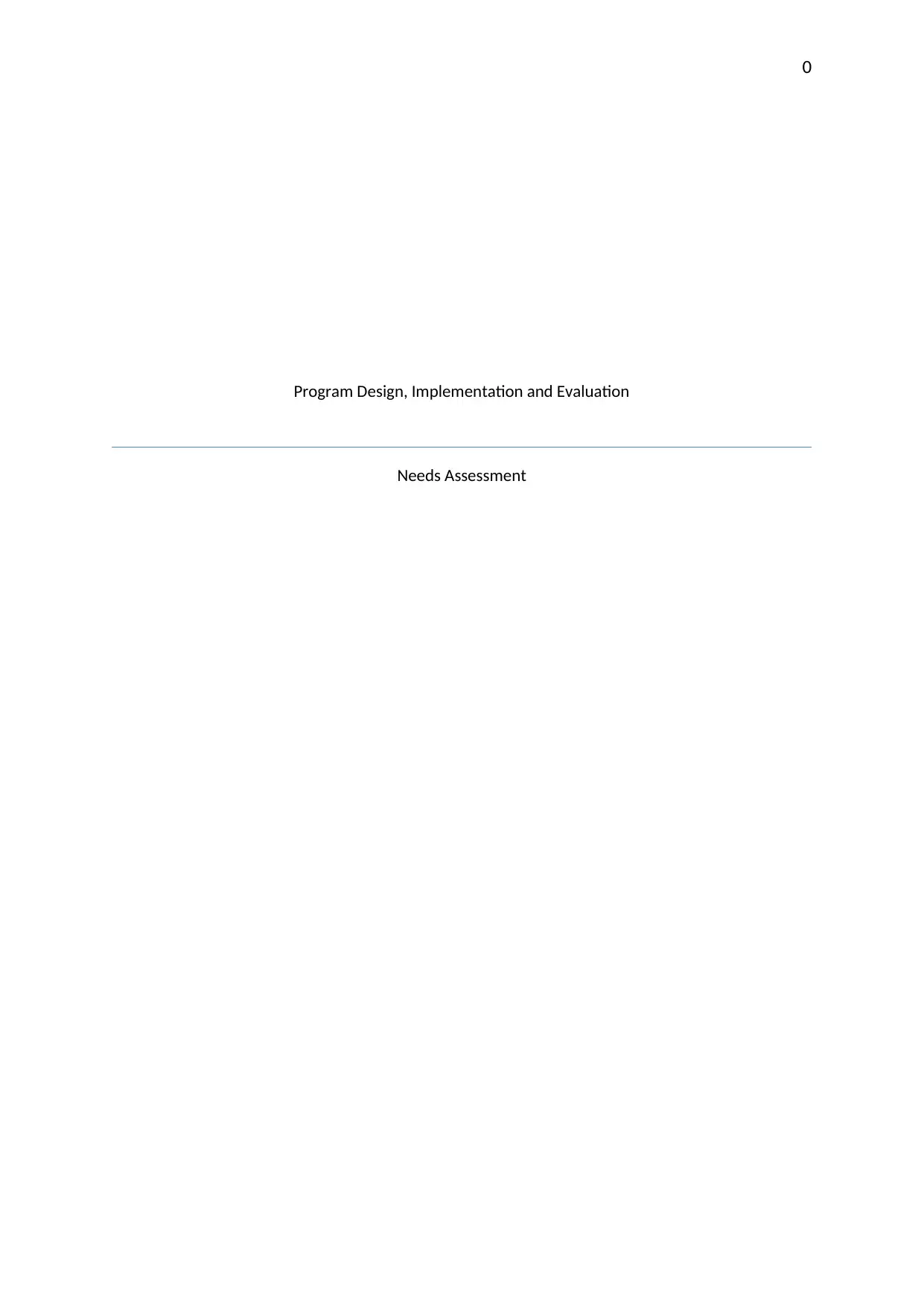
0
Program Design, Implementation and Evaluation
Needs Assessment
Program Design, Implementation and Evaluation
Needs Assessment
Paraphrase This Document
Need a fresh take? Get an instant paraphrase of this document with our AI Paraphraser
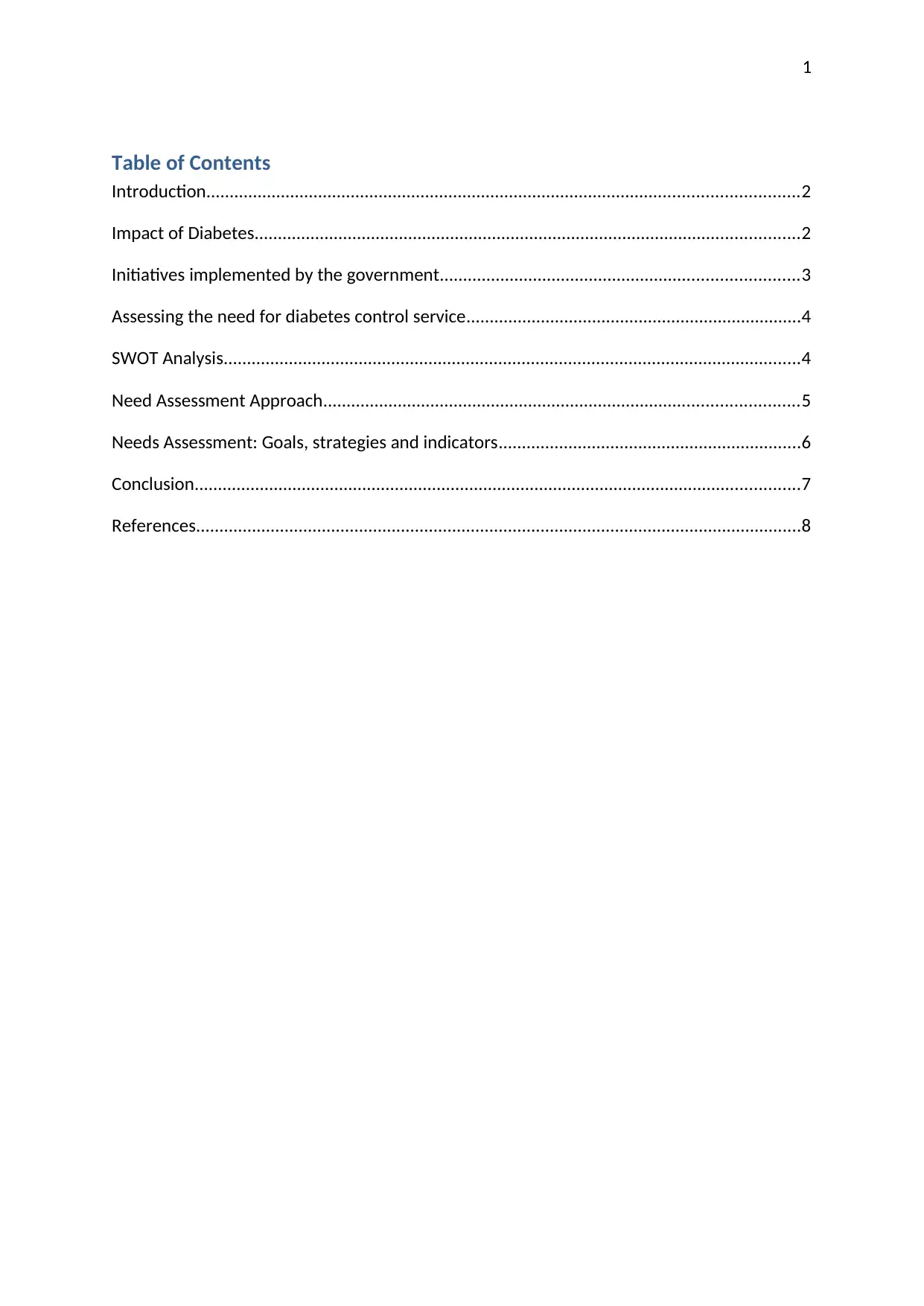
1
Table of Contents
Introduction...............................................................................................................................2
Impact of Diabetes.....................................................................................................................2
Initiatives implemented by the government.............................................................................3
Assessing the need for diabetes control service........................................................................4
SWOT Analysis............................................................................................................................4
Need Assessment Approach......................................................................................................5
Needs Assessment: Goals, strategies and indicators.................................................................6
Conclusion..................................................................................................................................7
References..................................................................................................................................8
Table of Contents
Introduction...............................................................................................................................2
Impact of Diabetes.....................................................................................................................2
Initiatives implemented by the government.............................................................................3
Assessing the need for diabetes control service........................................................................4
SWOT Analysis............................................................................................................................4
Need Assessment Approach......................................................................................................5
Needs Assessment: Goals, strategies and indicators.................................................................6
Conclusion..................................................................................................................................7
References..................................................................................................................................8
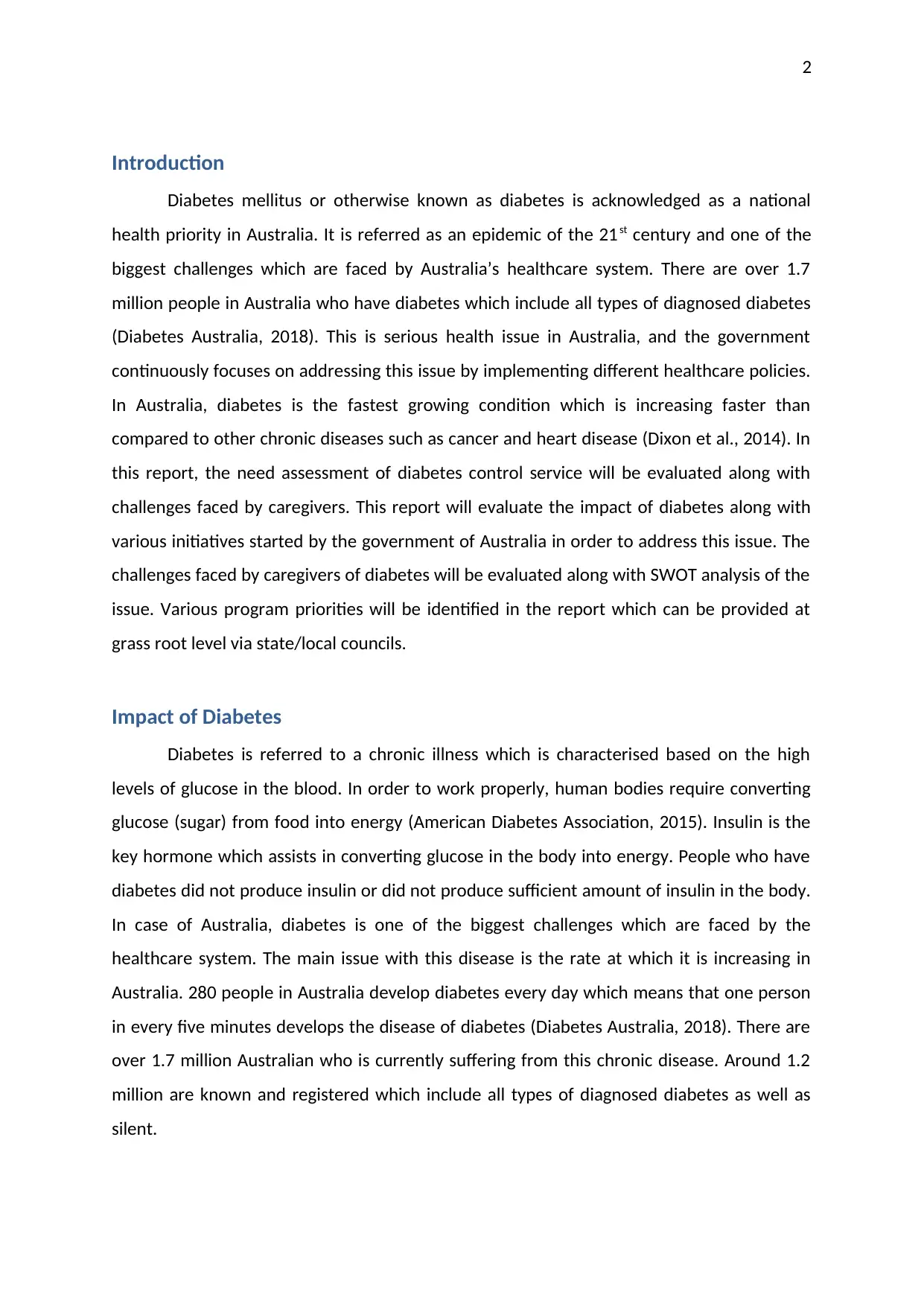
2
Introduction
Diabetes mellitus or otherwise known as diabetes is acknowledged as a national
health priority in Australia. It is referred as an epidemic of the 21st century and one of the
biggest challenges which are faced by Australia’s healthcare system. There are over 1.7
million people in Australia who have diabetes which include all types of diagnosed diabetes
(Diabetes Australia, 2018). This is serious health issue in Australia, and the government
continuously focuses on addressing this issue by implementing different healthcare policies.
In Australia, diabetes is the fastest growing condition which is increasing faster than
compared to other chronic diseases such as cancer and heart disease (Dixon et al., 2014). In
this report, the need assessment of diabetes control service will be evaluated along with
challenges faced by caregivers. This report will evaluate the impact of diabetes along with
various initiatives started by the government of Australia in order to address this issue. The
challenges faced by caregivers of diabetes will be evaluated along with SWOT analysis of the
issue. Various program priorities will be identified in the report which can be provided at
grass root level via state/local councils.
Impact of Diabetes
Diabetes is referred to a chronic illness which is characterised based on the high
levels of glucose in the blood. In order to work properly, human bodies require converting
glucose (sugar) from food into energy (American Diabetes Association, 2015). Insulin is the
key hormone which assists in converting glucose in the body into energy. People who have
diabetes did not produce insulin or did not produce sufficient amount of insulin in the body.
In case of Australia, diabetes is one of the biggest challenges which are faced by the
healthcare system. The main issue with this disease is the rate at which it is increasing in
Australia. 280 people in Australia develop diabetes every day which means that one person
in every five minutes develops the disease of diabetes (Diabetes Australia, 2018). There are
over 1.7 million Australian who is currently suffering from this chronic disease. Around 1.2
million are known and registered which include all types of diagnosed diabetes as well as
silent.
Introduction
Diabetes mellitus or otherwise known as diabetes is acknowledged as a national
health priority in Australia. It is referred as an epidemic of the 21st century and one of the
biggest challenges which are faced by Australia’s healthcare system. There are over 1.7
million people in Australia who have diabetes which include all types of diagnosed diabetes
(Diabetes Australia, 2018). This is serious health issue in Australia, and the government
continuously focuses on addressing this issue by implementing different healthcare policies.
In Australia, diabetes is the fastest growing condition which is increasing faster than
compared to other chronic diseases such as cancer and heart disease (Dixon et al., 2014). In
this report, the need assessment of diabetes control service will be evaluated along with
challenges faced by caregivers. This report will evaluate the impact of diabetes along with
various initiatives started by the government of Australia in order to address this issue. The
challenges faced by caregivers of diabetes will be evaluated along with SWOT analysis of the
issue. Various program priorities will be identified in the report which can be provided at
grass root level via state/local councils.
Impact of Diabetes
Diabetes is referred to a chronic illness which is characterised based on the high
levels of glucose in the blood. In order to work properly, human bodies require converting
glucose (sugar) from food into energy (American Diabetes Association, 2015). Insulin is the
key hormone which assists in converting glucose in the body into energy. People who have
diabetes did not produce insulin or did not produce sufficient amount of insulin in the body.
In case of Australia, diabetes is one of the biggest challenges which are faced by the
healthcare system. The main issue with this disease is the rate at which it is increasing in
Australia. 280 people in Australia develop diabetes every day which means that one person
in every five minutes develops the disease of diabetes (Diabetes Australia, 2018). There are
over 1.7 million Australian who is currently suffering from this chronic disease. Around 1.2
million are known and registered which include all types of diagnosed diabetes as well as
silent.
⊘ This is a preview!⊘
Do you want full access?
Subscribe today to unlock all pages.

Trusted by 1+ million students worldwide
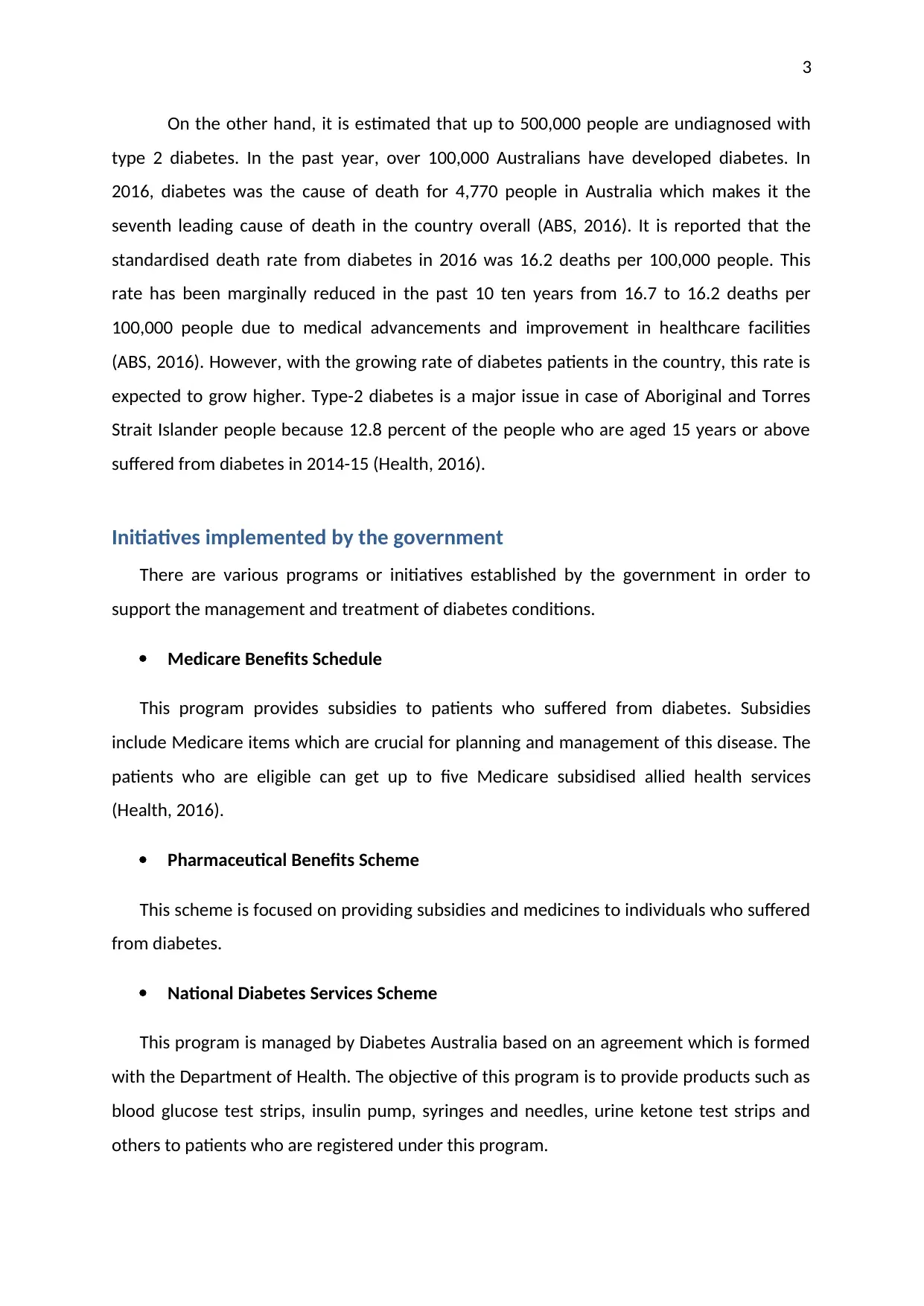
3
On the other hand, it is estimated that up to 500,000 people are undiagnosed with
type 2 diabetes. In the past year, over 100,000 Australians have developed diabetes. In
2016, diabetes was the cause of death for 4,770 people in Australia which makes it the
seventh leading cause of death in the country overall (ABS, 2016). It is reported that the
standardised death rate from diabetes in 2016 was 16.2 deaths per 100,000 people. This
rate has been marginally reduced in the past 10 ten years from 16.7 to 16.2 deaths per
100,000 people due to medical advancements and improvement in healthcare facilities
(ABS, 2016). However, with the growing rate of diabetes patients in the country, this rate is
expected to grow higher. Type-2 diabetes is a major issue in case of Aboriginal and Torres
Strait Islander people because 12.8 percent of the people who are aged 15 years or above
suffered from diabetes in 2014-15 (Health, 2016).
Initiatives implemented by the government
There are various programs or initiatives established by the government in order to
support the management and treatment of diabetes conditions.
Medicare Benefits Schedule
This program provides subsidies to patients who suffered from diabetes. Subsidies
include Medicare items which are crucial for planning and management of this disease. The
patients who are eligible can get up to five Medicare subsidised allied health services
(Health, 2016).
Pharmaceutical Benefits Scheme
This scheme is focused on providing subsidies and medicines to individuals who suffered
from diabetes.
National Diabetes Services Scheme
This program is managed by Diabetes Australia based on an agreement which is formed
with the Department of Health. The objective of this program is to provide products such as
blood glucose test strips, insulin pump, syringes and needles, urine ketone test strips and
others to patients who are registered under this program.
On the other hand, it is estimated that up to 500,000 people are undiagnosed with
type 2 diabetes. In the past year, over 100,000 Australians have developed diabetes. In
2016, diabetes was the cause of death for 4,770 people in Australia which makes it the
seventh leading cause of death in the country overall (ABS, 2016). It is reported that the
standardised death rate from diabetes in 2016 was 16.2 deaths per 100,000 people. This
rate has been marginally reduced in the past 10 ten years from 16.7 to 16.2 deaths per
100,000 people due to medical advancements and improvement in healthcare facilities
(ABS, 2016). However, with the growing rate of diabetes patients in the country, this rate is
expected to grow higher. Type-2 diabetes is a major issue in case of Aboriginal and Torres
Strait Islander people because 12.8 percent of the people who are aged 15 years or above
suffered from diabetes in 2014-15 (Health, 2016).
Initiatives implemented by the government
There are various programs or initiatives established by the government in order to
support the management and treatment of diabetes conditions.
Medicare Benefits Schedule
This program provides subsidies to patients who suffered from diabetes. Subsidies
include Medicare items which are crucial for planning and management of this disease. The
patients who are eligible can get up to five Medicare subsidised allied health services
(Health, 2016).
Pharmaceutical Benefits Scheme
This scheme is focused on providing subsidies and medicines to individuals who suffered
from diabetes.
National Diabetes Services Scheme
This program is managed by Diabetes Australia based on an agreement which is formed
with the Department of Health. The objective of this program is to provide products such as
blood glucose test strips, insulin pump, syringes and needles, urine ketone test strips and
others to patients who are registered under this program.
Paraphrase This Document
Need a fresh take? Get an instant paraphrase of this document with our AI Paraphraser
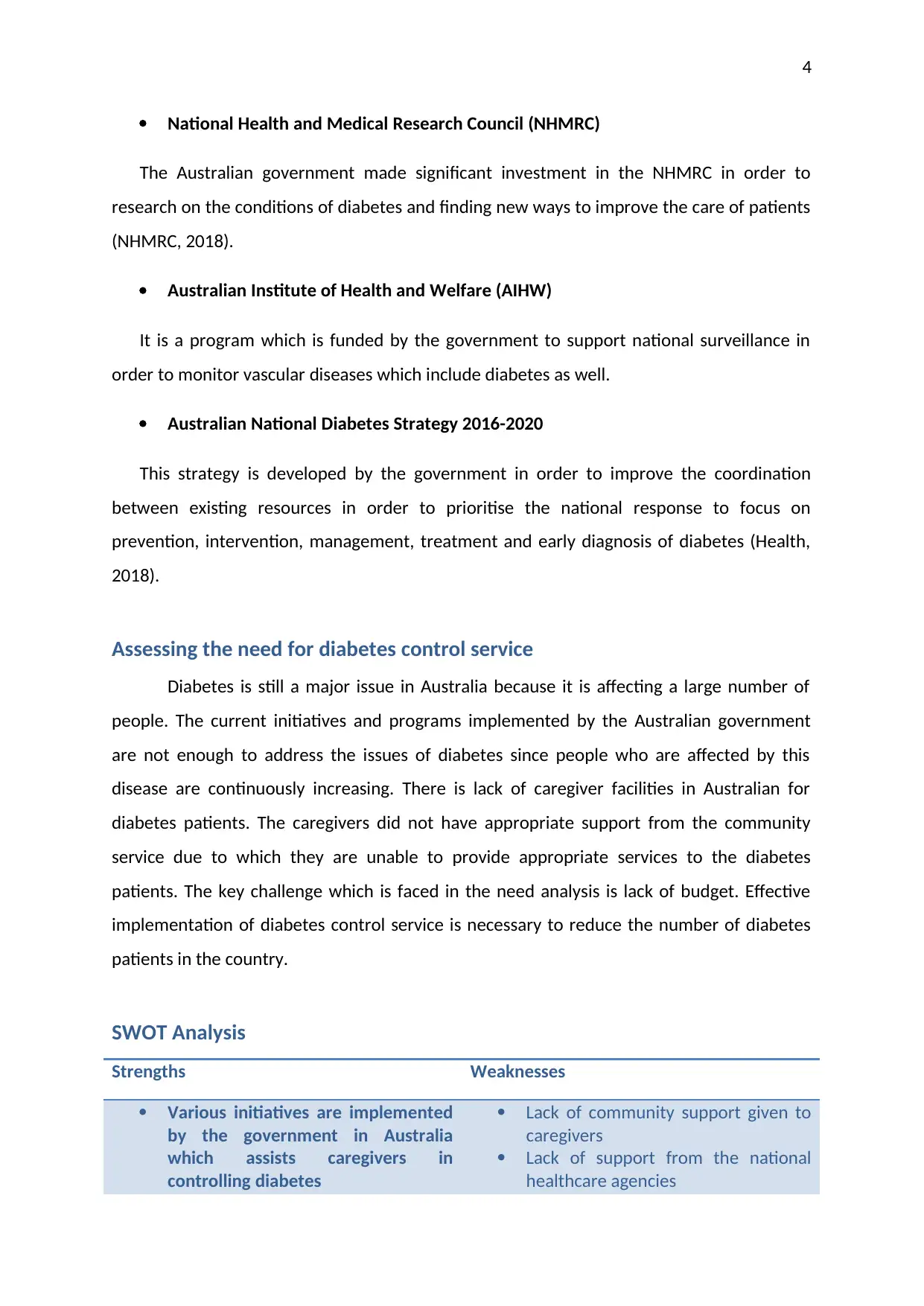
4
National Health and Medical Research Council (NHMRC)
The Australian government made significant investment in the NHMRC in order to
research on the conditions of diabetes and finding new ways to improve the care of patients
(NHMRC, 2018).
Australian Institute of Health and Welfare (AIHW)
It is a program which is funded by the government to support national surveillance in
order to monitor vascular diseases which include diabetes as well.
Australian National Diabetes Strategy 2016-2020
This strategy is developed by the government in order to improve the coordination
between existing resources in order to prioritise the national response to focus on
prevention, intervention, management, treatment and early diagnosis of diabetes (Health,
2018).
Assessing the need for diabetes control service
Diabetes is still a major issue in Australia because it is affecting a large number of
people. The current initiatives and programs implemented by the Australian government
are not enough to address the issues of diabetes since people who are affected by this
disease are continuously increasing. There is lack of caregiver facilities in Australian for
diabetes patients. The caregivers did not have appropriate support from the community
service due to which they are unable to provide appropriate services to the diabetes
patients. The key challenge which is faced in the need analysis is lack of budget. Effective
implementation of diabetes control service is necessary to reduce the number of diabetes
patients in the country.
SWOT Analysis
Strengths Weaknesses
Various initiatives are implemented
by the government in Australia
which assists caregivers in
controlling diabetes
Lack of community support given to
caregivers
Lack of support from the national
healthcare agencies
National Health and Medical Research Council (NHMRC)
The Australian government made significant investment in the NHMRC in order to
research on the conditions of diabetes and finding new ways to improve the care of patients
(NHMRC, 2018).
Australian Institute of Health and Welfare (AIHW)
It is a program which is funded by the government to support national surveillance in
order to monitor vascular diseases which include diabetes as well.
Australian National Diabetes Strategy 2016-2020
This strategy is developed by the government in order to improve the coordination
between existing resources in order to prioritise the national response to focus on
prevention, intervention, management, treatment and early diagnosis of diabetes (Health,
2018).
Assessing the need for diabetes control service
Diabetes is still a major issue in Australia because it is affecting a large number of
people. The current initiatives and programs implemented by the Australian government
are not enough to address the issues of diabetes since people who are affected by this
disease are continuously increasing. There is lack of caregiver facilities in Australian for
diabetes patients. The caregivers did not have appropriate support from the community
service due to which they are unable to provide appropriate services to the diabetes
patients. The key challenge which is faced in the need analysis is lack of budget. Effective
implementation of diabetes control service is necessary to reduce the number of diabetes
patients in the country.
SWOT Analysis
Strengths Weaknesses
Various initiatives are implemented
by the government in Australia
which assists caregivers in
controlling diabetes
Lack of community support given to
caregivers
Lack of support from the national
healthcare agencies
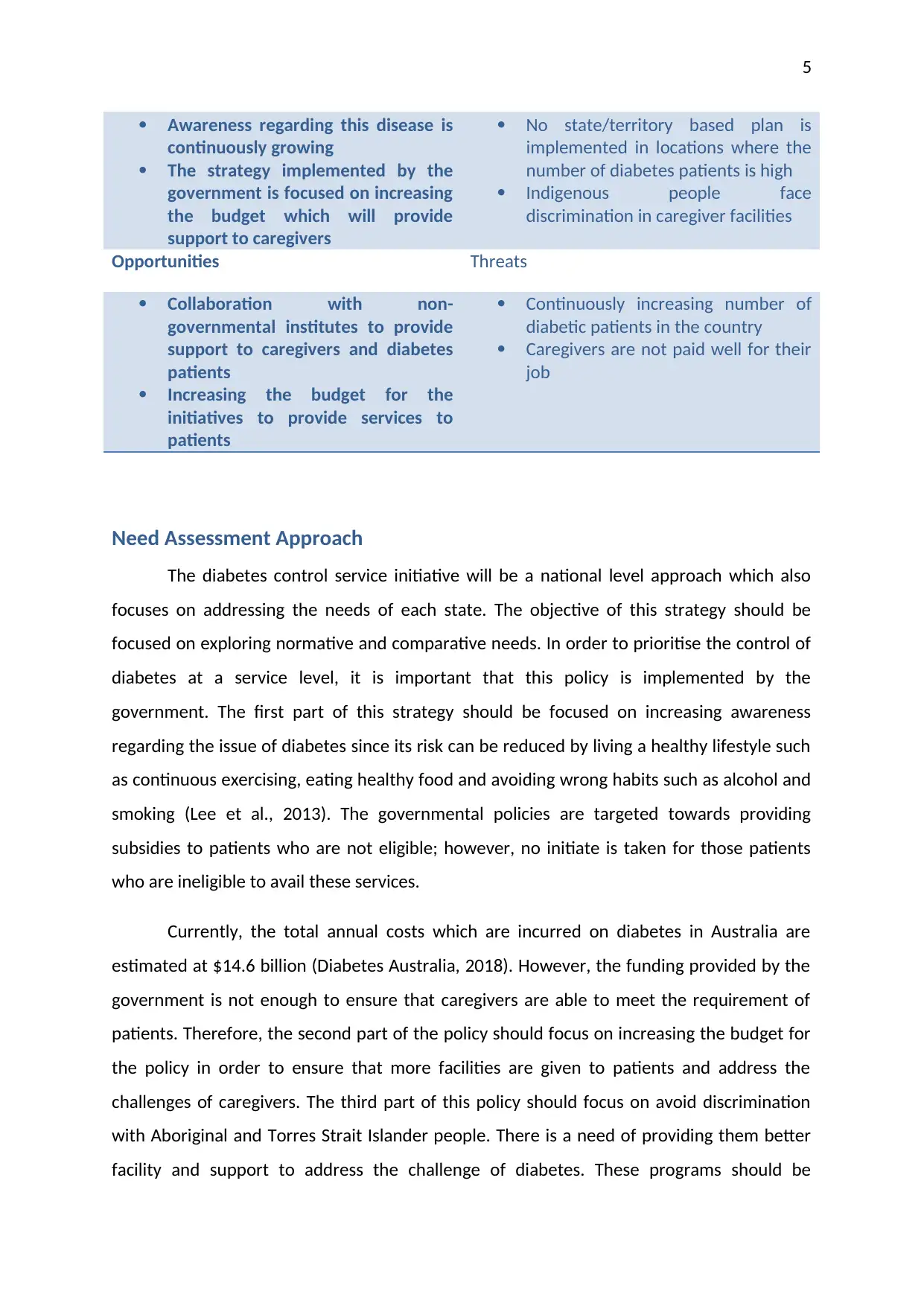
5
Awareness regarding this disease is
continuously growing
The strategy implemented by the
government is focused on increasing
the budget which will provide
support to caregivers
No state/territory based plan is
implemented in locations where the
number of diabetes patients is high
Indigenous people face
discrimination in caregiver facilities
Opportunities Threats
Collaboration with non-
governmental institutes to provide
support to caregivers and diabetes
patients
Increasing the budget for the
initiatives to provide services to
patients
Continuously increasing number of
diabetic patients in the country
Caregivers are not paid well for their
job
Need Assessment Approach
The diabetes control service initiative will be a national level approach which also
focuses on addressing the needs of each state. The objective of this strategy should be
focused on exploring normative and comparative needs. In order to prioritise the control of
diabetes at a service level, it is important that this policy is implemented by the
government. The first part of this strategy should be focused on increasing awareness
regarding the issue of diabetes since its risk can be reduced by living a healthy lifestyle such
as continuous exercising, eating healthy food and avoiding wrong habits such as alcohol and
smoking (Lee et al., 2013). The governmental policies are targeted towards providing
subsidies to patients who are not eligible; however, no initiate is taken for those patients
who are ineligible to avail these services.
Currently, the total annual costs which are incurred on diabetes in Australia are
estimated at $14.6 billion (Diabetes Australia, 2018). However, the funding provided by the
government is not enough to ensure that caregivers are able to meet the requirement of
patients. Therefore, the second part of the policy should focus on increasing the budget for
the policy in order to ensure that more facilities are given to patients and address the
challenges of caregivers. The third part of this policy should focus on avoid discrimination
with Aboriginal and Torres Strait Islander people. There is a need of providing them better
facility and support to address the challenge of diabetes. These programs should be
Awareness regarding this disease is
continuously growing
The strategy implemented by the
government is focused on increasing
the budget which will provide
support to caregivers
No state/territory based plan is
implemented in locations where the
number of diabetes patients is high
Indigenous people face
discrimination in caregiver facilities
Opportunities Threats
Collaboration with non-
governmental institutes to provide
support to caregivers and diabetes
patients
Increasing the budget for the
initiatives to provide services to
patients
Continuously increasing number of
diabetic patients in the country
Caregivers are not paid well for their
job
Need Assessment Approach
The diabetes control service initiative will be a national level approach which also
focuses on addressing the needs of each state. The objective of this strategy should be
focused on exploring normative and comparative needs. In order to prioritise the control of
diabetes at a service level, it is important that this policy is implemented by the
government. The first part of this strategy should be focused on increasing awareness
regarding the issue of diabetes since its risk can be reduced by living a healthy lifestyle such
as continuous exercising, eating healthy food and avoiding wrong habits such as alcohol and
smoking (Lee et al., 2013). The governmental policies are targeted towards providing
subsidies to patients who are not eligible; however, no initiate is taken for those patients
who are ineligible to avail these services.
Currently, the total annual costs which are incurred on diabetes in Australia are
estimated at $14.6 billion (Diabetes Australia, 2018). However, the funding provided by the
government is not enough to ensure that caregivers are able to meet the requirement of
patients. Therefore, the second part of the policy should focus on increasing the budget for
the policy in order to ensure that more facilities are given to patients and address the
challenges of caregivers. The third part of this policy should focus on avoid discrimination
with Aboriginal and Torres Strait Islander people. There is a need of providing them better
facility and support to address the challenge of diabetes. These programs should be
⊘ This is a preview!⊘
Do you want full access?
Subscribe today to unlock all pages.

Trusted by 1+ million students worldwide
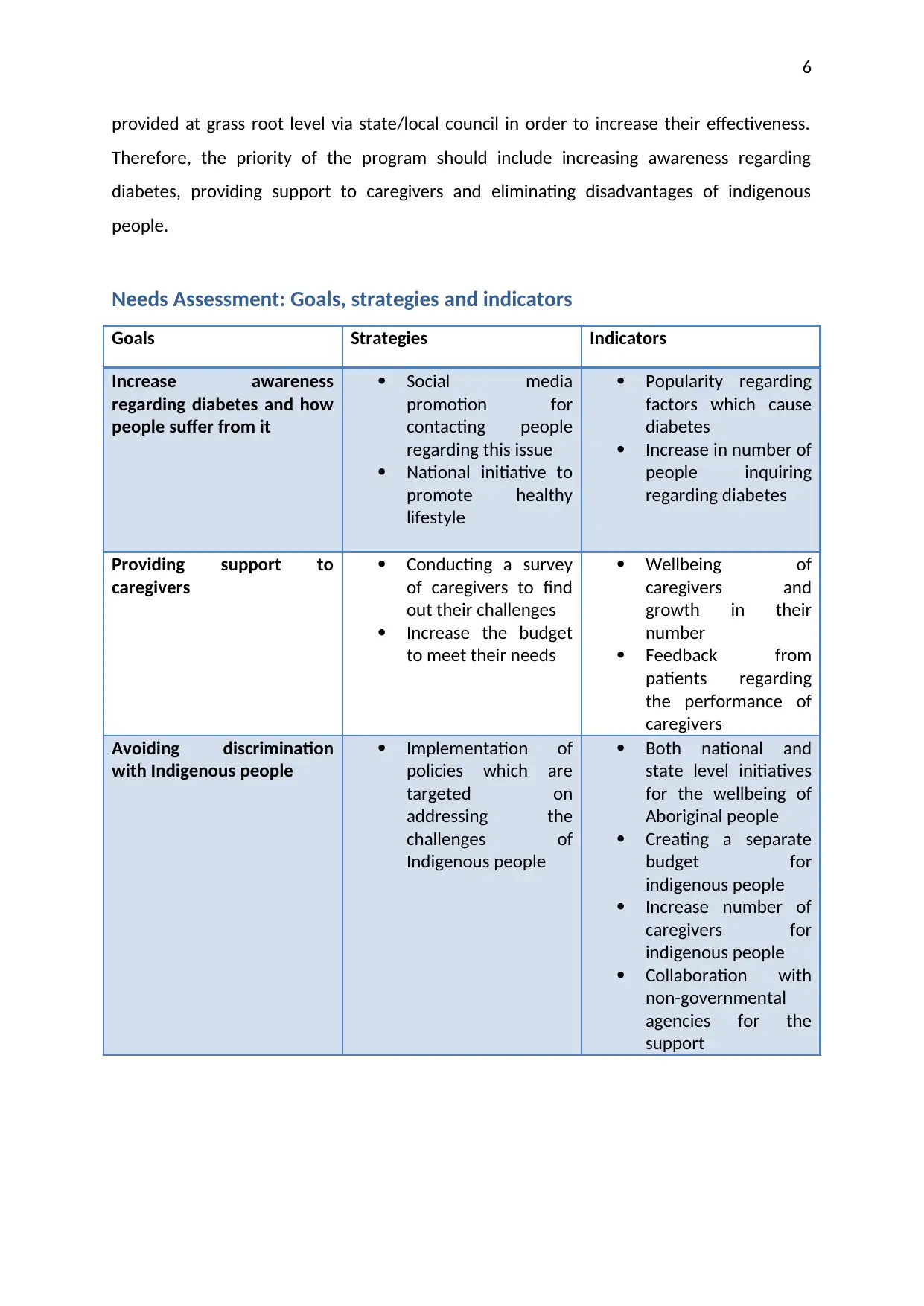
6
provided at grass root level via state/local council in order to increase their effectiveness.
Therefore, the priority of the program should include increasing awareness regarding
diabetes, providing support to caregivers and eliminating disadvantages of indigenous
people.
Needs Assessment: Goals, strategies and indicators
Goals Strategies Indicators
Increase awareness
regarding diabetes and how
people suffer from it
Social media
promotion for
contacting people
regarding this issue
National initiative to
promote healthy
lifestyle
Popularity regarding
factors which cause
diabetes
Increase in number of
people inquiring
regarding diabetes
Providing support to
caregivers
Conducting a survey
of caregivers to find
out their challenges
Increase the budget
to meet their needs
Wellbeing of
caregivers and
growth in their
number
Feedback from
patients regarding
the performance of
caregivers
Avoiding discrimination
with Indigenous people
Implementation of
policies which are
targeted on
addressing the
challenges of
Indigenous people
Both national and
state level initiatives
for the wellbeing of
Aboriginal people
Creating a separate
budget for
indigenous people
Increase number of
caregivers for
indigenous people
Collaboration with
non-governmental
agencies for the
support
provided at grass root level via state/local council in order to increase their effectiveness.
Therefore, the priority of the program should include increasing awareness regarding
diabetes, providing support to caregivers and eliminating disadvantages of indigenous
people.
Needs Assessment: Goals, strategies and indicators
Goals Strategies Indicators
Increase awareness
regarding diabetes and how
people suffer from it
Social media
promotion for
contacting people
regarding this issue
National initiative to
promote healthy
lifestyle
Popularity regarding
factors which cause
diabetes
Increase in number of
people inquiring
regarding diabetes
Providing support to
caregivers
Conducting a survey
of caregivers to find
out their challenges
Increase the budget
to meet their needs
Wellbeing of
caregivers and
growth in their
number
Feedback from
patients regarding
the performance of
caregivers
Avoiding discrimination
with Indigenous people
Implementation of
policies which are
targeted on
addressing the
challenges of
Indigenous people
Both national and
state level initiatives
for the wellbeing of
Aboriginal people
Creating a separate
budget for
indigenous people
Increase number of
caregivers for
indigenous people
Collaboration with
non-governmental
agencies for the
support
Paraphrase This Document
Need a fresh take? Get an instant paraphrase of this document with our AI Paraphraser
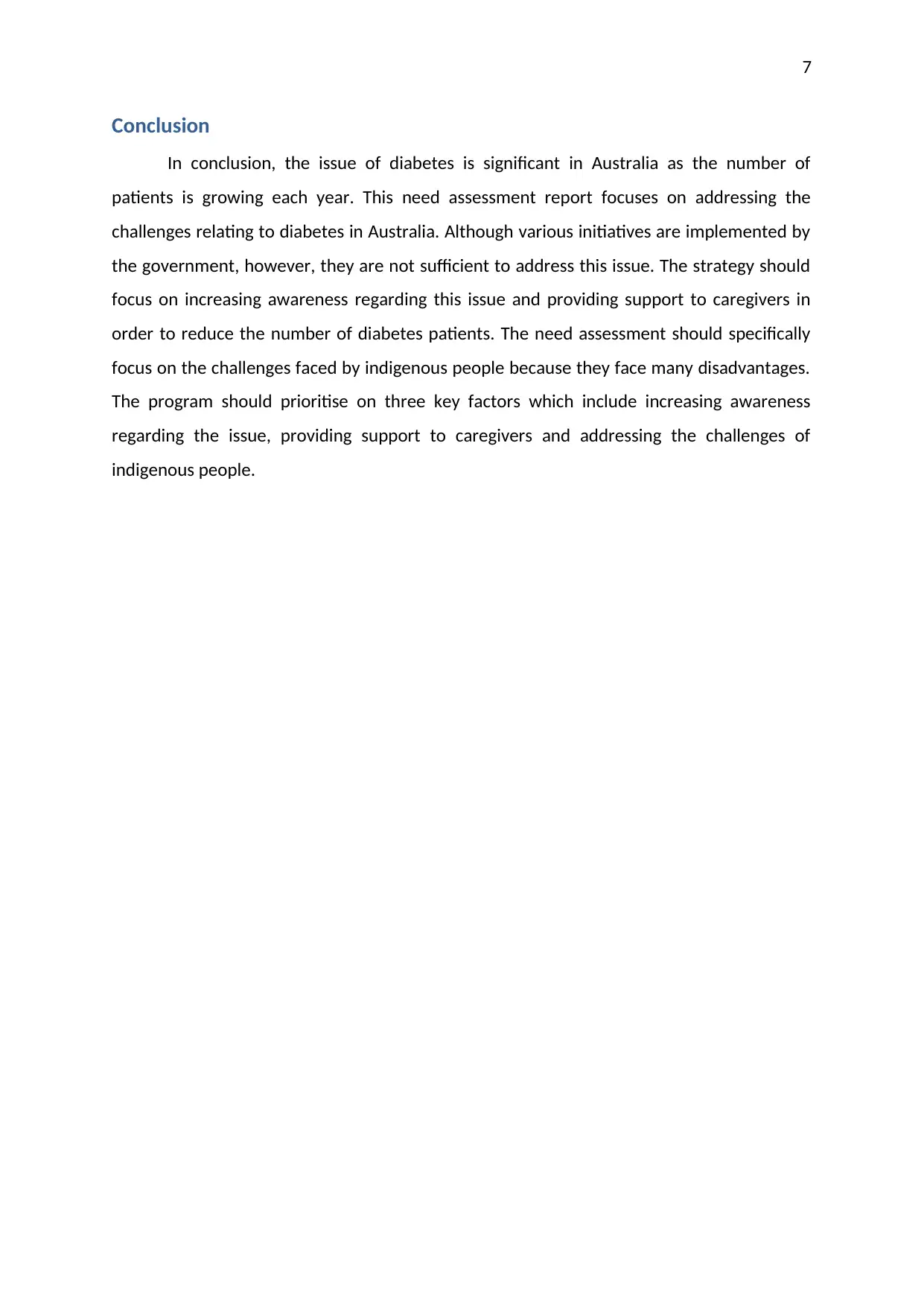
7
Conclusion
In conclusion, the issue of diabetes is significant in Australia as the number of
patients is growing each year. This need assessment report focuses on addressing the
challenges relating to diabetes in Australia. Although various initiatives are implemented by
the government, however, they are not sufficient to address this issue. The strategy should
focus on increasing awareness regarding this issue and providing support to caregivers in
order to reduce the number of diabetes patients. The need assessment should specifically
focus on the challenges faced by indigenous people because they face many disadvantages.
The program should prioritise on three key factors which include increasing awareness
regarding the issue, providing support to caregivers and addressing the challenges of
indigenous people.
Conclusion
In conclusion, the issue of diabetes is significant in Australia as the number of
patients is growing each year. This need assessment report focuses on addressing the
challenges relating to diabetes in Australia. Although various initiatives are implemented by
the government, however, they are not sufficient to address this issue. The strategy should
focus on increasing awareness regarding this issue and providing support to caregivers in
order to reduce the number of diabetes patients. The need assessment should specifically
focus on the challenges faced by indigenous people because they face many disadvantages.
The program should prioritise on three key factors which include increasing awareness
regarding the issue, providing support to caregivers and addressing the challenges of
indigenous people.
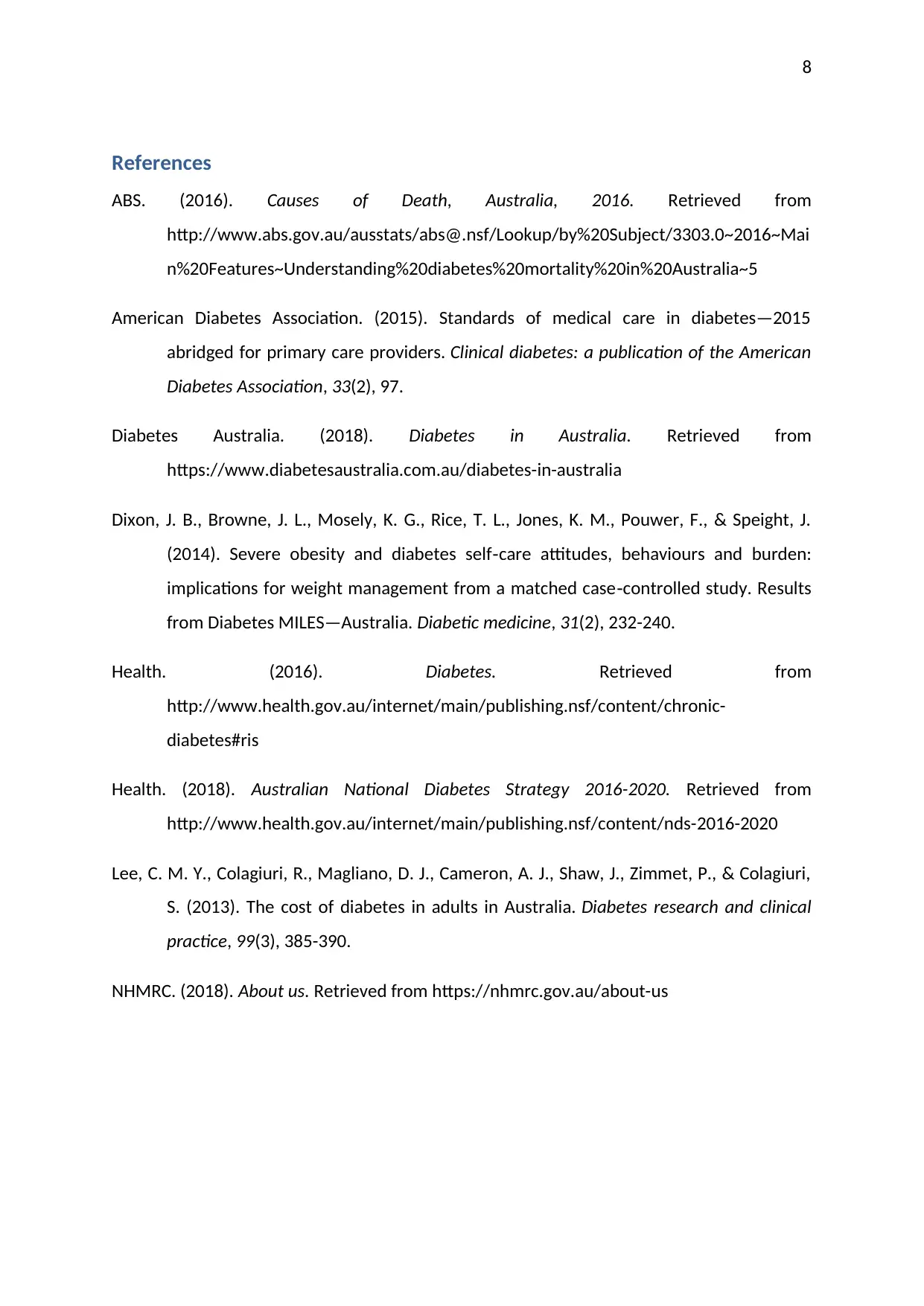
8
References
ABS. (2016). Causes of Death, Australia, 2016. Retrieved from
http://www.abs.gov.au/ausstats/abs@.nsf/Lookup/by%20Subject/3303.0~2016~Mai
n%20Features~Understanding%20diabetes%20mortality%20in%20Australia~5
American Diabetes Association. (2015). Standards of medical care in diabetes—2015
abridged for primary care providers. Clinical diabetes: a publication of the American
Diabetes Association, 33(2), 97.
Diabetes Australia. (2018). Diabetes in Australia. Retrieved from
https://www.diabetesaustralia.com.au/diabetes-in-australia
Dixon, J. B., Browne, J. L., Mosely, K. G., Rice, T. L., Jones, K. M., Pouwer, F., & Speight, J.
(2014). Severe obesity and diabetes self‐care attitudes, behaviours and burden:
implications for weight management from a matched case‐controlled study. Results
from Diabetes MILES—Australia. Diabetic medicine, 31(2), 232-240.
Health. (2016). Diabetes. Retrieved from
http://www.health.gov.au/internet/main/publishing.nsf/content/chronic-
diabetes#ris
Health. (2018). Australian National Diabetes Strategy 2016-2020. Retrieved from
http://www.health.gov.au/internet/main/publishing.nsf/content/nds-2016-2020
Lee, C. M. Y., Colagiuri, R., Magliano, D. J., Cameron, A. J., Shaw, J., Zimmet, P., & Colagiuri,
S. (2013). The cost of diabetes in adults in Australia. Diabetes research and clinical
practice, 99(3), 385-390.
NHMRC. (2018). About us. Retrieved from https://nhmrc.gov.au/about-us
References
ABS. (2016). Causes of Death, Australia, 2016. Retrieved from
http://www.abs.gov.au/ausstats/abs@.nsf/Lookup/by%20Subject/3303.0~2016~Mai
n%20Features~Understanding%20diabetes%20mortality%20in%20Australia~5
American Diabetes Association. (2015). Standards of medical care in diabetes—2015
abridged for primary care providers. Clinical diabetes: a publication of the American
Diabetes Association, 33(2), 97.
Diabetes Australia. (2018). Diabetes in Australia. Retrieved from
https://www.diabetesaustralia.com.au/diabetes-in-australia
Dixon, J. B., Browne, J. L., Mosely, K. G., Rice, T. L., Jones, K. M., Pouwer, F., & Speight, J.
(2014). Severe obesity and diabetes self‐care attitudes, behaviours and burden:
implications for weight management from a matched case‐controlled study. Results
from Diabetes MILES—Australia. Diabetic medicine, 31(2), 232-240.
Health. (2016). Diabetes. Retrieved from
http://www.health.gov.au/internet/main/publishing.nsf/content/chronic-
diabetes#ris
Health. (2018). Australian National Diabetes Strategy 2016-2020. Retrieved from
http://www.health.gov.au/internet/main/publishing.nsf/content/nds-2016-2020
Lee, C. M. Y., Colagiuri, R., Magliano, D. J., Cameron, A. J., Shaw, J., Zimmet, P., & Colagiuri,
S. (2013). The cost of diabetes in adults in Australia. Diabetes research and clinical
practice, 99(3), 385-390.
NHMRC. (2018). About us. Retrieved from https://nhmrc.gov.au/about-us
⊘ This is a preview!⊘
Do you want full access?
Subscribe today to unlock all pages.

Trusted by 1+ million students worldwide
1 out of 9
Related Documents
Your All-in-One AI-Powered Toolkit for Academic Success.
+13062052269
info@desklib.com
Available 24*7 on WhatsApp / Email
![[object Object]](/_next/static/media/star-bottom.7253800d.svg)
Unlock your academic potential
Copyright © 2020–2025 A2Z Services. All Rights Reserved. Developed and managed by ZUCOL.





